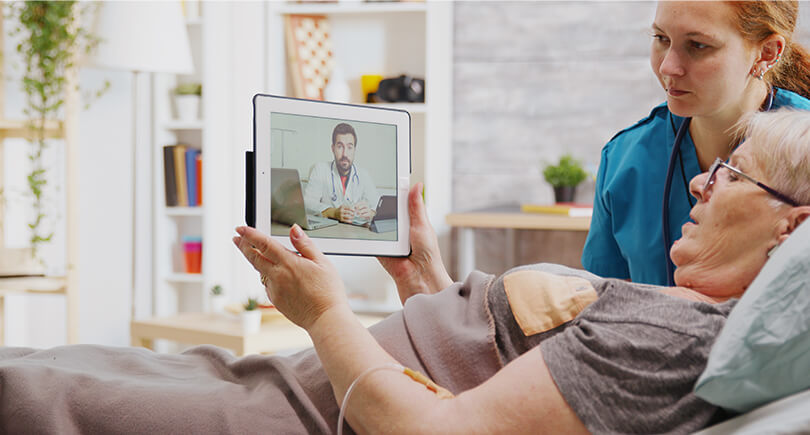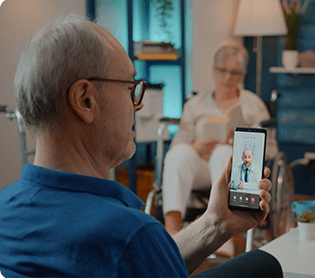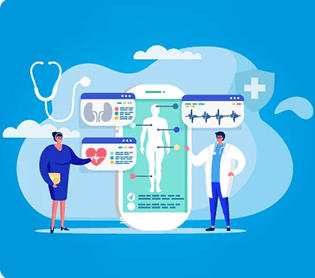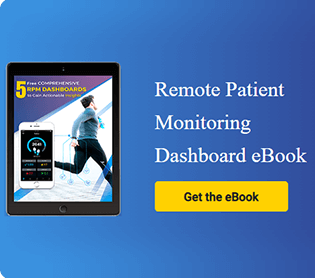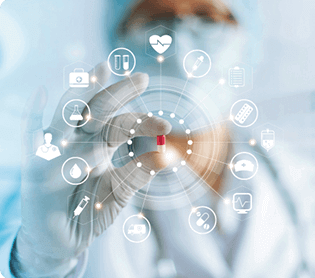Introduction:
Mobile Patient Monitoring Systems today are gaining momentum in the healthcare industry. Digital tools and services like electronic health records or patient engagement systems are changing the paradigm of care delivery and treatments. Similarly, mobile patient monitoring system enhances remote patient monitoring and telehealth. This system depends on mobile computing and wireless technology to facilitate continuous communication of the essential vitals of the patient.
Providers and healthcare management both advocate how this new mobile patient monitoring ensures efficiency and convenience of patients. As part of mHealth, mobile remote patient monitoring also helps providers and health organizations amplify their remote patient monitoring system to provide quality care, maximum practitioners’ flexibility, and enhanced patient experience.
Besides, in any practice management, the patient monitoring system offers many benefits. So, if you are interested in building a mobile patient monitoring system for your organization, here is a complete guide on this. This guide focuses on developing a mobile patient monitoring system from scratch. However, before you shift your focus on the process, you must understand the potential barriers and benefits of mobile patient monitoring in healthcare.
Barriers in Developing a Mobile Patient Monitoring System
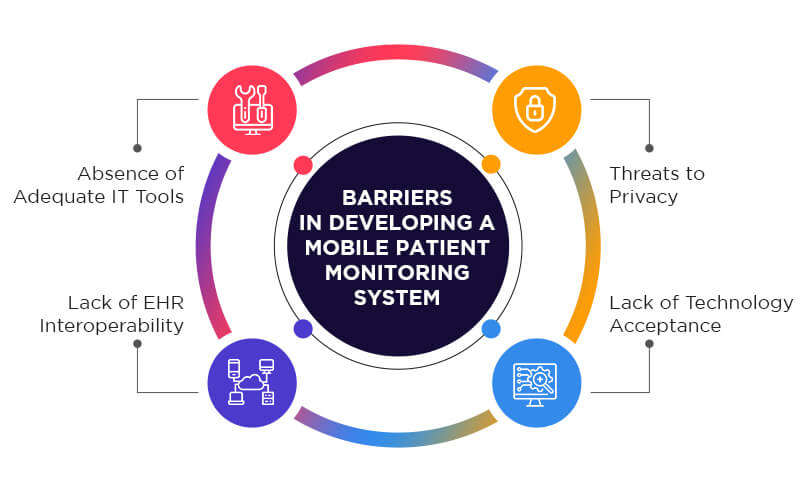
Healthcare providers are plagued by rising care costs and the increasing chronic and geriatric population. So, healthcare IT leaders and providers resorted to remote patient monitoring applications to keep track of patients’ bio-signal and bio-markers. This helps physicians to make informed health decisions for patients’ better health. However, providers and healthcare organizations are skeptical of developing and implementing a mobile patient monitoring system due to these roadblocks.
1. Threats to Privacy
Any integrated health solutions or mobile health applications have the most common obstacle- the threat to data security. Mobile healthcare solutions keep track of the significant body vitals to ensure patients’ health stability all time. And these mobile patient monitoring devices and systems generate a massive amount of health data to help clinicians. However, the mobile monitoring application without HIPAA compliance imposes more privacy and security risks. So, providers and vendors developing mobile patient monitoring systems must comply with all regulations. This will assure users and patients safe and secure healthcare data management and electronic data exchange for better health outcomes.
2. Lack of technology acceptance
Another common barrier in developing mobile health monitoring systems is providers’ lack of acceptance of technology. With new emerging technological solutions, health providers benefit from the health applications. However, technology acceptance is still a challenge, as most providers are still skeptical about the most solutions. Moreover, remote patient monitoring systems have to deal with a huge amount of health data. And to manage this data, providers need medical informatics or healthcare analytical solutions. These additional investments impact providers’ financial and technical credibility. So, providers aren’t sure about developing such a remote health monitoring system.
3. Lack of EHR interoperability
Mobile patient monitoring systems generate a massive amount of patient health data. Even though providers today have EHR systems, the lack of healthcare interoperability poses a risk in sharing vital monitoring data across the care settings. This barrier affects the complete patient monitor software. Moreover, if your EHR system isn’t interoperable, there are chances of data loss, lack of adequate information to make clinical decisions support system, and more. So, providers need to ensure that their organizations have EHR interoperability to ensure seamless data exchange and storage. Some experts suggest that cloud-based storage is better and more secure than web interface-based applications.
4. Absence of Adequate IT Tools
Developing a mobile patient monitoring system is possible only with many IT tools. Healthcare providers lacking adequate IT resources face obstacles in developing a mobile patient monitoring system. The mobile remote patient monitoring systems will deliver effective results with the right set of IT tools such as medical records management applications.
How to Develop a Mobile Patient Monitoring System
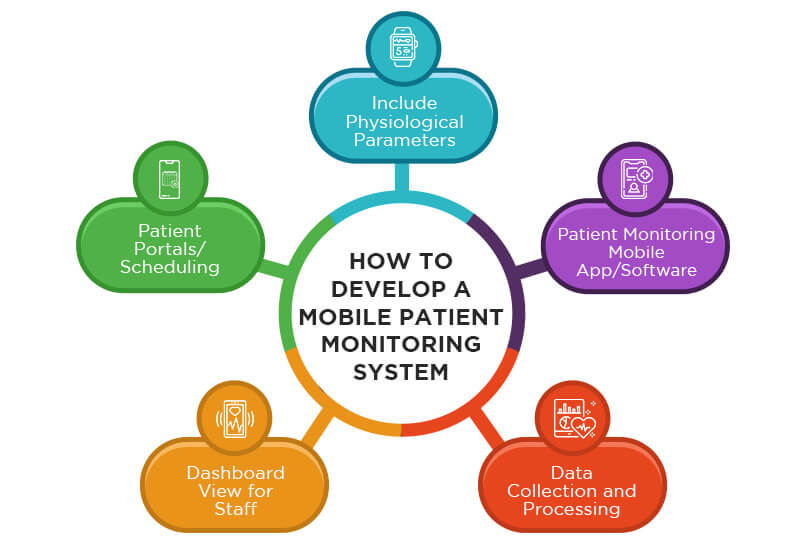
Healthcare management and providers inclined towards developing mobile patient monitoring systems can follow these steps.
1. Include Physiological parameters
The essential component or specification to include in any patient monitoring system is the physiological parameters. For instance, the remote patient monitoring system based on an application must collect patients’ physical vitals like heart rate, SpO2, pedometer, and more. These vitals help physicians get a basic understanding of the patient’s progress in the care episode. Providers developing a mobile patient monitoring system can integrate wearable devices data into their organization’s EHR to allow practitioners to get timely access to all critical patient health data.
2. Patient Monitoring mobile app/software
eHealth’s most significant service is mobile remote patient monitoring. And creating an application/software for remotely monitoring patients is the best way to timely track them and get accurate data. So, providers willing to invest in mobile patient monitoring must ensure that the app or software accurately addresses patients’ and providers’ needs for improved care delivery.
3. Data Collection and Processing
The patient monitoring system must include data collecting and processing features of all the essential specifications. In a mobile remote patient monitoring system, the data accumulated from the application or software is highly critical and sensitive. So, appropriate data collection and processing will benefit clinicians in making timely care decisions. Also, it helps physicians predict abnormalities in patients’ health. Besides, providers can go for cloud computing in healthcare or healthcare automation to ensure effective data collection and storage space.
4. Dashboard View for Staff
Another criterion required for developing a mobile patient monitoring system is the proper dashboard view for the staff. While patients have to use the application and device, providers need adequate features to view the different aspects of patient health through collected data. And the remote healthcare monitoring system with a comprehensive and easy-to-access dashboard for the staff will help them manage, access, and control data and patients more efficiently.
5. Patient Portals/ Scheduling
Integrating the mobile patient monitoring system with patient portals boosts the patient experience. Moreover, the patient portal with appointment scheduling, lab tests, and consultations enhances the monitoring systems. Besides, providers integrating patient portals with remote patient monitoring systems save money on additional costs. Overall, this integrated mobile patient monitoring system benefits patients giving them access to their data and effective treatments. This will help providers with population health management too.
Must-Have Features of Patient Monitoring App
To engineer a remote patient monitoring app, you must include these must-have features. Indeed, these features will ensure that the remote health monitoring app improves patient outcomes and make physicians’ work efficient.
1. Data Collection: An essential step in building a patient monitoring app is to collect patient health data in real time. This health data primarily includes body vitals such as temperature, weight, heart rate, blood pressure, height, activity data, etc. This data is typically sourced from wearables, apps like HealthKit, and GoogleFit, providers like HumanAPI, or sensors. As the data is collected, providers can easily make better care decisions based on that data.
2. Data Integration: In a remote healthcare monitoring app, data integration with practices or physicians is a must. Once the data is collected, the app must securely and seamlessly transfer this data to the specific practice or physician. Doing so will help doctors or hospitals to assess the patient’s condition and make necessary decisions. Moreover, this is possible through a secure API that will integrate EHR/EMR with the app. Perhaps, it’s essential that alongside the integrations, the app also adheres to the security regulations for data privacy.
3. Patient Engagement: A robust remote patient monitoring app must focus on patient engagement. It’s essential that patients can see their vitals and other health information so that they can keep track of their health too.
4. Secure Communication: Secure communication is another common feature of remote monitoring apps. Adding video calling capabilities, 2-way messaging, audio calls, and more can make patient-physician communication convenient and easier. But whatever the communication medium is, it’s important to ensure HIPAA and other regulatory compliance.
5. Notifications and Alert Systems: Often, patients forget about their upcoming appointment or to take medications. And it leads to health impacts. However, the remote monitoring app with notification and alerts feature can help resolve this problem. With such a feature, patients will be notified about their upcoming appointment and reminded about their medications. Not only will patients improve faster, but it will also save providers from additional costs.
6. Payment Gateway: Patients also have co-payments for insurance eligibility. And a patient monitoring app without a payment system will raise issues in making co-payments. However, adding secure and multiple payment options to enable patients to make direct payments is much needed. Moreover, such payment gateways help providers view the history and invoices.
Factors to Consider to Make a Successful Mobile Patient Monitoring System
1. UI/UX: Patient user experience matters greatly, especially in remote patient monitoring systems. As everyone isn’t tech savvy, ensuring the application is easy to navigate with a simple user interface is better. If the interface is complicated and patients can’t find the right features, it’ll be a complete mess, and patients might avoid using it completely. Hence, ensuring a user interface with interactive features is better to enhance the user experience.
2. Security Compliance: Mobile patient monitoring systems must comply with security regulations. HIPAA, FDA, HL7, SOC2 Type2, ISO27001, and IEC 62304 are the most common regulatory names the remote health monitoring app must adhere to. Typically, during the development of such patient monitoring apps, integration with these security systems is the best. This will ensure full compliance and maintain the privacy of patient health data.
3. Battery Optimization: The remote patient monitoring device continuously tracks health vitals. That means the software or app is constantly running to gather the data. And that would reflect on the battery. So, developers need to pay attention to battery optimization to ensure that the app/system is successful.
4. Analytics: Having business intelligence and data visualization tools in the remote monitoring apps is a must-have, as it’s a hit among providers. Doctors require proper visualization tools to analyze patient health data and make informed decisions. Interactive dashboards are typically effective in visualizing data and helping doctors predict risky events. Such dashboards can efficiently highlight patterns and trends in patients’ conditions and enable caregivers to sketch the right treatment plan.
5. Offline Mode: Having internet problems is quite common. However, that mustn’t stop patients from the patient monitoring system. Storing all data on the cloud in case of no internet is a must. Developers can ensure this through a caching mechanism that stores all data on the cloud and resyncs back when the internet is available. This will enhance the patient experience and enable doctors to access crucial health data whenever required, even when the internet is down. Besides, one can use tools like NSURLCache, and OkHttpClient for effective caching mechanisms.
6. Advanced Features: A remote health monitoring app isn’t just limited to tracking health vitals and care deliveries; some advanced features can enhance it for the better. Features like geolocation and voice recognition can make patient monitoring apps more effective. It will improve user experience and surely be a hit among patients. Imagine having a home health remote patient monitoring app with a geolocation feature. This will help home health patients find the nearest clinic or pharmacy in emergencies. Similarly, adding voice recognition to the app will make it easier for senior patients to find care services.
7. Regular Updates: A remote monitoring app requires work even after it’s completely ready. It needs constant monitoring to identify functionality and navigation issues, troubleshoot those issues to fix them, and get user feedback. Besides, regular updates will only enhance the user experience, ensuring that the app remains up-to-date with the regulations. Regular updates will also help developers to add advanced features for better service.
Key Benefits of a Mobile Patient Monitoring System
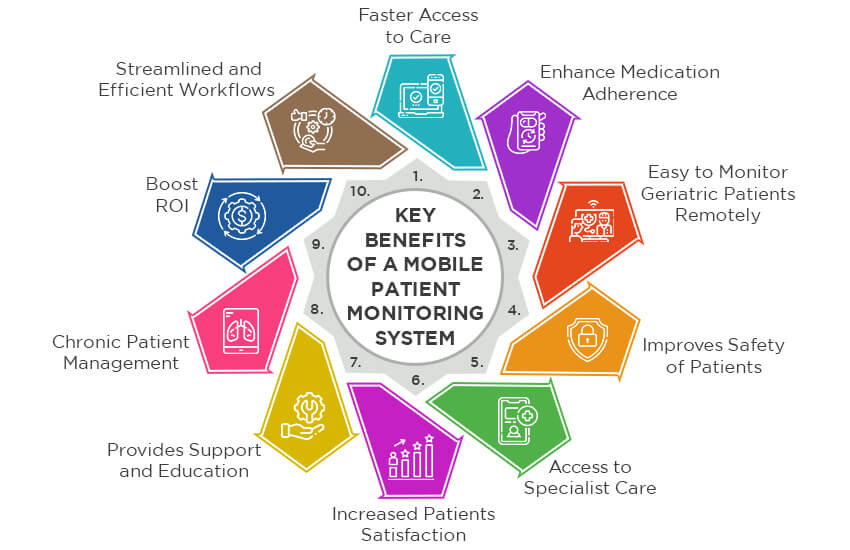
Now that you know how to develop a mobile patient monitoring system, here are benefits that you’ll get-
1. Faster Access to Care
There’s no debate that clinicians will provide faster access to care with patient monitor software or remote patient monitoring apps. Moreover, patients with such a health monitoring application can easily book an appointment, keep track of bio-signals and get effective care.
2. Enhance medication adherence
One of the key benefits of mobile patient monitoring systems is improving patients’ adherence to medication. With patients taking medication timely, providers are benefitted from minimum readmissions, faster recovery, value-based care, and an excellent patient experience.
3. Easy to Monitor Geriatric patients remotely
Today, the geriatric and chronic patient population increases exponentially. Consistent tracking and remote monitoring have become a necessity to manage the health of such patients. Here mobile patient monitoring systems help, as it enables providers to monitor senior, chronic and high-risk patients continuously. And give these patients timely treatments and high-quality care.
4. Improves Safety of Patients
The current pandemic situation has triggered the growth of mHealth and remote patient monitoring systems. However, pandemic or not, these mobile health applications assure the utmost safety of patients. Providers get timely updates and make informed decisions too for effective care delivery.
5. Access to Specialist Care
Several areas or communities need help to get access to specialist care. The reasons are typically a lack of specialist care units. Whether the patients need psychiatric care or acute care specialists, mobile remote patient monitoring apps can effectively cater to this requirement. Getting easy access to specialists through mobile RPM apps is convenient and cost-effective. After all, it’s time-consuming for patients at places with limited or no availability of specialty care to drive back and forth. Moreover, visiting specialty hospitals increases the risks of hospital-acquired infections, especially for older adults. Mobile patient monitoring systems can easily negate all these.
6. Increased Patients Satisfaction
It is strangely reassuring to know that someone is constantly watching your well-being from a psychological standpoint. As today’s patients are increasingly involved in their health and wellness, they’ll feel truly valued when there is a constant point of contact/communication from providers. And with doctors well-informed about their health conditions, patients will also be more attentive and accountable for their health. For example, they will not skip normal exercise or medications. This way, the overall patient satisfaction rate will increase, and providers can earn more credibility and loyalty from their patients.
7. Provides Support and Education
Remote health monitoring devices allow easy communication between a doctor and a patient. Compared to routine appointments, this may allow patients to receive additional information and comments regarding their medical conditions. These apps help patients visualize health metrics and provide other health-related information. And with reminders and alerts features, patients can monitor their medications and appointments to ensure a faster recovery. RPM apps can accommodate each patient’s particular requirements. For instance, the app might include tailored coaching or goal-setting tools to assist patients in achieving their health objectives. Aside from using AI algorithms, the app may also offer tailored recommendations depending on the patient’s health information.
8. Chronic Patient Management
Today, remote patient monitoring platforms and apps are mostly used for chronic care management. 90% of healthcare costs in the US are related to chronic illnesses. While many of these can be better managed by patient behavior but using real-time data is more impactful. By receiving and analyzing more real-time patient-generated data, such as blood glucose in diabetes and blood pressure in hypertension, and tracking patients’ physical activity, weight, and prescriptions, clinicians can better treat chronic illnesses. This gives healthcare professionals a chance to offer the necessary advice and take prompt action.
9. Boost ROI
As per a study published in Medical Internet Research, remote patient monitoring apps reduced hospital readmissions by 48% and saved nearly $8375 per patient on average. To be precise, patient monitoring systems can reduce the cost of care for hospitals by increasing their savings. Moreover, now that remote services are also easily coded and billed, healthcare practices can generate more revenue without spending a lot on patient visits.
10. Streamlined and Efficient Workflows
Health monitoring applications can streamline workflows and make it easier for patients to access care. And providers, on the other hand, need not stress about administrative chores. Patients can stay out of the clinic, avoid long times in waiting areas, avoid appointments or reports delays, and save emergency hospital admissions with RPM. These elements lead to a lighter burden on the healthcare systems and facilitate more efficient operations.
Types of Mobile Patient Monitoring Apps
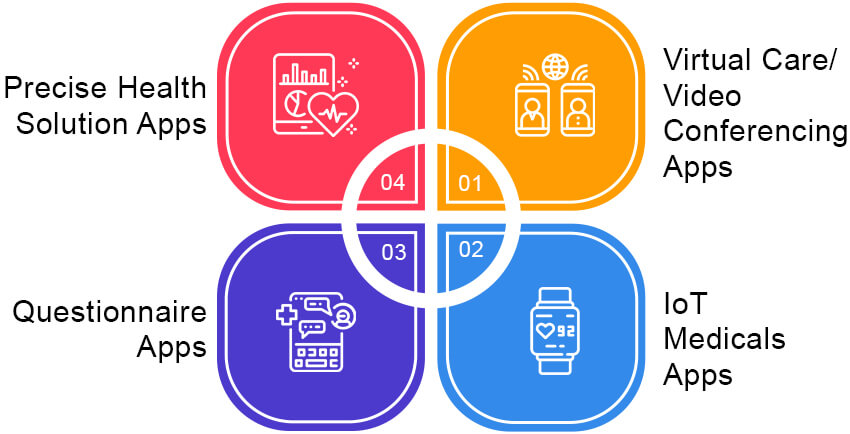
1. Virtual Care/Video Conferencing Apps
Video conferencing apps, the mHealth app, can directly connect with the doctor virtually. These remote patient monitoring apps offer users the convenience of receiving quality care from the comfort of their homes. And these apps improve communication between providers and patients. OSP can tailor personalized RPM apps for video conferencing to ensure a practical and comfortable way of accessing quality healthcare.
2. IoT Medicals Apps
IoT health apps gather information from wearables using smart sensors and fitness trackers, then communicate the data to monitoring groups to ensure better treatments. These applications are becoming increasingly popular due to alert systems and reminders. We at OSP can custom-build such IoT apps that connect with wearables and other sensor-based devices to provide an accurate view of health data.
3. Questionnaire Apps
Clinical trial companies or just regular health organizations often conduct surveys to collect health information from different players, typically patients. While these are simple remote health monitoring applications, it’s quite useful, especially for population health management. These apps are quite affordable and less complicated than IoT apps. We can develop questionnaire apps that can easily cater to the specific needs of any medical practice.
4. Precise Health Solution Apps
Precise health solution apps only gather private patient health data for research. There is no communication between a doctor and a patient when using such apps. We can build such apps to facilitate clinical research and other health studies.
Conclusion
Todays’ healthcare scenario is changing and is becoming heavily dependent on technology. mHealth and remote monitoring apps benefit providers and patients in many ways. However, providers trying to develop such a mobile patient monitoring app must understand their organizational requirements, plan a budget, and include essential specifications. Opting for a customized mobile patient monitoring system is more beneficial for providers and patients. So, investing in a vendor service for the same is a wise choice. Above all, the mobile patient monitoring system is a great technology solution to boost patients’ health and experience with the provider.
OSP is a trusted software development company that delivers bespoke solutions as per your business needs. Connect with us to hire the best talents in the industry to build enterprise-grade software.

How can we help?
Fill out the short form below or call us at (888) 846-5382
Looking for software solutions to build your product?
Let's discuss your software solutions for your product in our free development acceleration call!
Get In Touch arrow_forwardDiscuss Your Project Handover with a team of expert Book a free consultation arrow_forward
About Author

Written by Riken Shah linkedin
Riken's work motto is to help healthcare providers use technological advancements to make healthcare easily accessible to all stakeholders, from providers to patients. Under his leadership and guidance, OSP Labs has successfully developed over 600 customized software solutions for 200+ healthcare clients across continents.







